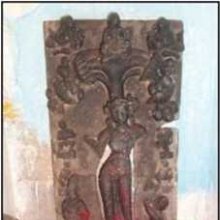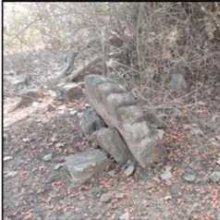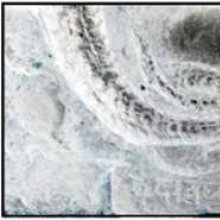Tumba: 22 definitions
Introduction:
Tumba means something in Hinduism, Sanskrit, Jainism, Prakrit, Buddhism, Pali, Marathi, Hindi, biology. If you want to know the exact meaning, history, etymology or English translation of this term then check out the descriptions on this page. Add your comment or reference to a book if you want to contribute to this summary article.
Tumba has 21 English definitions available.
Images (photo gallery)
Languages of India and abroad
Sanskrit dictionary
[Deutsch Wörterbuch]
Source: Cologne Digital Sanskrit Dictionaries: Böhtlingk and Roth Grosses Petersburger WörterbuchTumba (तुम्ब):—
1) m. Flaschengurke, Lagenaria vulgaris Ser. (die Frucht wohl n.) [Bharata] zu [Amarakoṣa] [Śabdakalpadruma] [Suśruta 1, 363, 1.] sumatistu garbhaṃ tumbaṃ vyajāyata [Rāmāyaṇa 1, 39, 17 (Gorresio 40, 17).] saśikyatumbakarakau (kṛṣṇasaṃkarṣaṇau) [Harivaṃśa 3479.] tumbavīṇa der eine Flaschengurke zur Laute hat, Beiname Śiva’s [Mahābhārata 13, 1213.] [Śivanāmasahasra] zum Schwimmen gebraucht [Scholiast] zu [Kātyāyana’s Śrautasūtrāṇi 971, 2] v. u. —
2) f. ā a) dass. [Śabdaratnāvalī im Śabdakalpadruma] — b) Milcheimer [Trikāṇḍaśeṣa 2, 9, 16.] Milchkuh [Wilson’s Wörterbuch] nach derselb. Aut. —
3) f. ī a) = tumba Flaschengurke [Amarakoṣa 2, 4, 5, 21.] [Hemacandra’s Abhidhānacintāmaṇi 1155.] [Suśruta 1, 183, 17. 2, 174, 19.] stanayugalatumbīphalayuta [Śihlana’s Śāntiśataka 3, 16.] puṣpa [Hārāvalī 202.] tumbīṃ vījapūrṇām [Harivaṃśa 802.] tumbīvīṇā [3618.] tumbīvīṇāpriya Beiw. Śiva’s [Mahābhārata 12, 10371.] Vgl. kaṭu, kumbha, gorakṣa . — b) Asteracantha longifolia Nees. [Ratnamālā 54.]
Source: Cologne Digital Sanskrit Dictionaries: Sanskrit-Wörterbuch in kürzerer FassungTumba (तुम्ब):——
1) m. f. ( ī) Flaschengurke , Lagenaria vulgaris (die Pflanze und die Frucht) [Indische studien von Weber 14,397.] —
2) *f. ā Milcheimer. —
3) *f. ī Asteracantha longifolia.
Sanskrit, also spelled संस्कृतम् (saṃskṛtam), is an ancient language of India commonly seen as the grandmother of the Indo-European language family (even English!). Closely allied with Prakrit and Pali, Sanskrit is more exhaustive in both grammar and terms and has the most extensive collection of literature in the world, greatly surpassing its sister-languages Greek and Latin.
See also (Relevant definitions)
Starts with (+17): Tumba-codiveli, Tumba-djali, Tumbabana, Tumbadi, Tumbadibava, Tumbae, Tumbaga, Tumbai, Tumbai-cheddi, Tumbajoda, Tumbaka, Tumbakataha, Tumbaki, Tumbakya, Tumbala, Tumbalaka, Tumbalanem, Tumbali, Tumbaluha, Tumbanem.
Ends with (+14): Avibhaktakutumba, Carim-tumba, Ekatumba, Gartumba, Gattatumba, Gorakhatumba, Kacatumba, Kappattumba, Karintumba, Katthatumba, Katu-tumba, Kautumba, Kolikutumba, Kotumba, Kudukutumba, Kulakutumba, Kustumba, Kutumba, Mahakutumba, Mutumba.
Full-text (+25): Tumbavana, Tumbi, Tumbaka, Tumbuka, Tumbini, Tumbika, Tumbavina, Tumba-codiveli, Umana tumba, Carim-tumba, Tumba-djali, Tumbabana, Tumbavarca, Tumpalai, Tumbivina, Tubam, Tumbajoda, Ekatumba, Tumbara, Dantekada.
Relevant text
Search found 11 books and stories containing Tumba, Tumbā, Tuṃbā, Tuṃba; (plurals include: Tumbas, Tumbās, Tuṃbās, Tuṃbas). You can also click to the full overview containing English textual excerpts. Below are direct links for the most relevant articles:
Vinaya (3): The Cullavagga (by T. W. Rhys Davids)
Cullavagga, Khandaka 5, Chapter 10 < [Khandaka 5 - On the Daily Life of the Bhikkhus]
Yoga Vasistha [English], Volume 1-4 (by Vihari-Lala Mitra)
Chapter xxxvi < [Book III - Utpatti khanda (utpatti khanda)]
Bhagavati-sutra (Viyaha-pannatti) (by K. C. Lalwani)
Chapter 10: Indras’ assemblies < [Book 3]
The Skanda Purana (by G. V. Tagare)
Chapter 1 - Nārada’s Vision of Yajñavarāha (Stationed on the Peak of Sumeru) < [Section 1 - Veṅkaṭācala-māhātmya]
Jain Remains of Ancient Bengal (by Shubha Majumder)
Jainism in ancient Bengal during the early medieval period < [Chapter 3 - Historical Background of Jainism in Ancient Bengal]
Abandoned Temples/Structural Ruins Containing Sculptural Specimens < [Chapter 5 - Jaina Architectural and Sculptural Remains]
Śāsanadevīs or Yakṣiṇīs from Ancient Bengal < [Chapter 6 - Iconographic Study of Jaina Sculptural Remains]
Kautilya Arthashastra (by R. Shamasastry)
Chapter 3 - The Application of Medicines and Mantras < [Book 14 - Secret Means]


